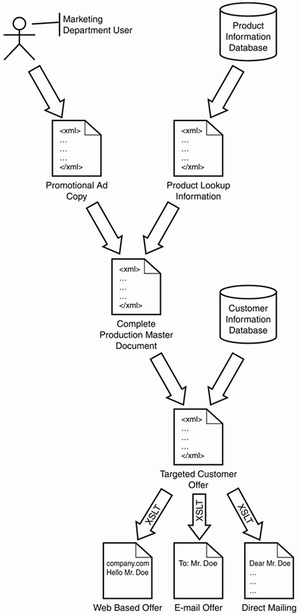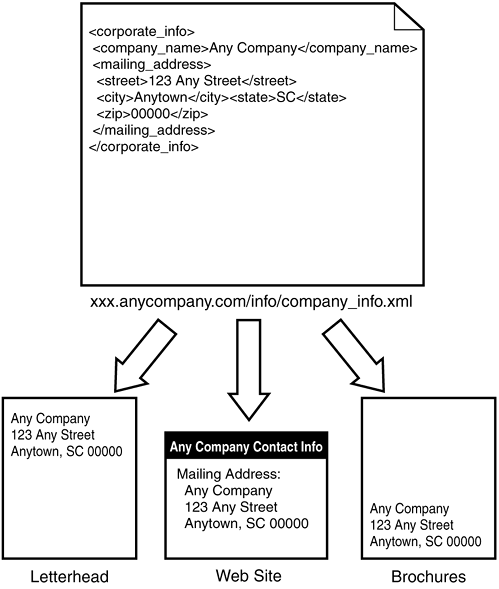Types of Customer Interactions
Studying customer behavior is an entire subscience of product marketing. Although the IT department might not be directly involved with sales and marketing plans, the information systems that it provides must be capable of supporting the campaigns and promotions required to promote and sell the company's products.
Knowing what types of information must be presented to a customer at different phases of the acquisition cycle makes system design decisions simpler.
Unsolicited Advertising
What can a new technology such as XML offer to traditional advertising media such as direct mail, print, radio, and so on? Marketing and communications agencies are traditionally slow to adopt new technologies. The growing importance of the Web and Internet-based marketing has forced them to update their skills and systems to meet the demand for technologically sophisticated advertising campaigns.
One possible application of XML to product advertising and promotion is in the area of unsolicited advertising. The content of e-mail-based advertising and the content of direct-mail campaigns frequently overlap. Using a common XML format to contain the information for a particular promotion reduces the chances of erroneous or inconsistent information being disseminated to customers. Figure 6.1 shows how XML documents could be combined and transformed to produce targeted advertising collateral.
Figure 6.1. Merging XML data into targeted customer offers.

A single well-designed XML template can simplify building current and future promotions, while eliminating information replication errors. As customer relationship management (CRM) applications become more sophisticated, the need for automated tools to construct campaigns and promotions becomes readily apparent.
Company Information
Particularly on the Internet, being able to present accurate and easy-to-index information about your company is the key to good search engine placement. By storing financial information, press releases, and investor information in XML format and then generating HTML pages on demand, company information is guaranteed to be fresh and consistent. This also makes the job of the Web designers easier because they can focus on the look and feel of the site without having to be involved in the creation of the actual page content. Figure 6.2 shows how corporate information can be kept current through the use of a single, canonical XML document source. This document need not be a static file, but could draw content from other XML data sources (such as an XML-aware database).
Figure 6.2. Retrieving corporate information from a central XML source.

Various government agencies are moving toward XML as a reporting format. The Securities and Exchange Commission (www.sec.gov) already allows companies to file their EDGAR documents in XML format. The U.S. Patent and Trademark Office (www.uspto.gov) is in the process of deploying new XML patent application forms. Although these programs are currently voluntary, the long-term trend toward eliminating paper-based forms cannot be ignored. Moving internal systems to XML can only help make that eventual transition less painful.
▸See Chapter 12, “Web Content Publishing” for an example of a system like this.
Product Documentation
Traditionally, product documentation is developed by a technical documentation team whose goal is to create attractive and complete printed documentation. As the demand for electronic and online documentation increased, hybrid approaches such as Microsoft's HTML help format were used with mixed results. One of the biggest problems facing documentation writers was that no single format was capable of containing all the information required for every possible output format.
HTML was ideal for displaying online help on the Web but was not suitable for producing high-quality printed documentation. Document-oriented formats such as PDF produced high-quality printed output but were too monolithic for use as a general-purpose online format. Compromises had to be made, and frequently the quality of the documentation suffered.
By building product documentation in XML, it is possible to satisfy not only current documentation requirements, but also future requirements. The open-ended nature of XML document construction makes it very easy to extend a basic document to incorporate additional information as it becomes necessary. Then, using XSLT, unnecessary information can be filtered out, depending on the target application. A public Web site could show content marked for general release, while internal reports could show additional proprietary information.
▸ See Chapter 18, “Unifying Product Documentation” for an example of this type of application.
Product Technical Support
Figure 6.3 shows how the same XML information source can be used to deliver product support information through multiple channels.
Figure 6.3. Delivering a single knowledge-base article via multiple channels.

Existing database solutions can be quickly adapted to XML delivery using new, XML-enabled versions of the underlying DB engine. The latest versions of both Microsoft's and Oracle's database products have built-in support for extracting SQL data in XML format. When the data is in XML format, XSLT transformations can be applied to produce content that is appropriate for Web, e-mail, or even fax delivery.
Premium support content can be maintained inline with free content using XML tags to differentiate. When the content is accessed by external users, the premium content is filtered out during the transformation process. Internal users and product support technicians can view the entire message, including any premium content.
▸See Chapter 18 for an example of this type of application.
